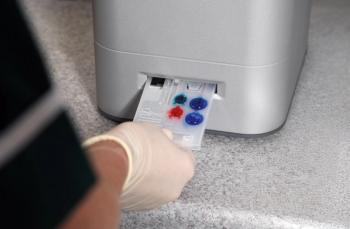
Patient records in a digital world
Practitioners ask: Is paperless really possible? Are electronic medical records worth the investment? Here's what early adopters say.
Dr. Howard Robinson with Brookfield Veterinary Hospital in Redmond, Wash., started his practice with the intention of being paperless. "Our lab reports, radiograph reports, and every kind of report we get are scanned into our computer as a PDF file when they come in, so they go directly into the patient file," he says. "Even faxes are received electronically, directly into the computer."
Not everything can go electronic, though. "We scan all our release forms, but because the owners sign those forms, we keep a hard copy and file it in a loose-leaf folder, just in case we need the original," he says.
Dr. Howard Gittleman of Animal Medical of New City in New City, N.Y., has moved toward complete EMRs but argues that at some point, there are diminishing returns. "Scanning every document into the patient's medical record just because we can adds considerable cost which doesn't translate into improved patient care," he says.
For these two practitioners, and others, a totally pristine, paperless environment isn't possible or practical. "I think the term 'paperless' is a misnomer," says Dr. Stephen Pittenger, president of the Association for Veterinary Informatics. "I know very few hospitals that use electronic medical records (EMRs) that don't still crank through a pretty decent amount of paper. For some things, it's easier to carry around and glance at a piece of paper."
Yet with user-friendly practice-management systems that can assimilate information previously spread across multiple places, moving to EMRs makes sense for many doctors. Even if they have to keep some paper files, these doctors cite many advantages of their electronic systems.
Data at your fingertips
"I feel strongly that veterinarians who don't use EMRs are missing the boat," says Dr. Dave Roos with Adobe Animal Hospital in Los Altos, Calif. "They're being inefficient."
In the trenches: Tips for a smooth transition to EMRs
Dr. Roos' practice has about 20 full- and part-time veterinarians, plus consultants who come and go, and everyone uses the computer system. "I can't imagine the pandemonium if they didn't," he says.
One of the biggest benefits: easy file storage and retrieval. "I enjoy never having to search for records around the practice," says Dr. Roos.
Dr. Robinson agrees. "We've never lost a chart," he says. "Not once. Plus, we have a computer by every telephone, so when a client calls, I can pull the file up within 15 seconds."
Clear-as-a-bell records
Another advantage: "Everybody can read everybody else's records," Dr. Gittleman says. "I've often been faced with the daunting task of trying to read handwritten records that are unintelligible. Hospitals are plagued by busy schedules and inadequate time to legibly document and organize patient medical records."
The records are also more complete, Dr. Gittleman says. He uses a template in his electronic system that prompts him to fill in details and populates common information.
All of this leads to "records that protect your butt," says Dr. Roos. "For example, you can create templates that spell out procedures. So when you say something like, 'I spayed a dog,' it describes the procedure in detail, with no effort. You write the explanation once and use it a few hundred times. And you can easily make little changes in the document for any case, if necessary."
"The expected standard in our profession is that the medical record has to be intelligible and everything has to be documented," says Dr. Gittleman. "The state boards of veterinary medicine have made it clear that they want veterinarians to thoroughly document their findings and recommendations made to clients. If it's not written down, the board can only conclude that the service or procedure wasn't performed." A well-designed electronic-management system, accessible from a tablet PC or console alongside the exam table, with software providing templates and checklists, makes it much easier to achieve the appropriate level of documentation, he says.
Virtually limitless access
Think of the possibilities: You could update files from a remote location. You could store files on a laptop and take them with you or connect to the network via the Internet. "I can talk to my practice consultant from home and log onto my practice software to review the data we're discussing," Dr. Robinson says. "And I can access patient files from home, too, if I need them."
In fact, with networking capabilities, doctors can work from anywhere. Dr. Gittleman says, "Wherever I am, I can dial in and know exactly what the situation is with a case. I can look at the medical records and the lab reports. I can even view radiographs or ultrasound images."
Even if you're in the practice, being able to find everything in one place—lab tests, prescriptions, treatment orders, and take-home sheets—makes it easy to see what was done previously, which helps you deliver better care more efficiently. "You can find things faster," says Dr. Pittenger. "Your records tend to be more complete. And better medical records generally mean better care."
With this increased efficiency, Dr. Pittenger continues, you can see more patients per day. "And my quality of life improved; I no longer end up with a stack of charts to write up on my desk at six o'clock," he says.
Every silver cloud has a dark lining
Of course, transitioning to EMRs isn't as simple as dumping your files in a trash can. You do have to buy the computers, if you don't already have them. "And you've got the cost of maintaining the hardware," Dr. Pittenger says.
User reviews: Veterinarians say some features prove more useful in practice than others
Depending on your team's computer expertise, you also may need to hire or contract with someone who can help maintain the system and deal with inevitable glitches. Finally, you need to consider the cost of upgrades.
"As software vendors update their programs, they do so using the latest operating systems," Dr. Robinson says. "If you're not using that operating system, you may need to upgrade that in addition to the practice management software." Besides the cost of the new systems, he's concerned about his hardware supporting the upgrades. "Someday I'll need to replace all our hardware, and I'm not looking forward to it," he says.
In the trenches: A day at a paperless practice
The total investment certainly could make you hesitate. On the other hand, you need to weigh the costs of employing staff members to look for files and deal with other inefficiencies of paper records, says Dr. Roos. "Keeping electronic records can be expensive," he says, "but we find the system pays for itself."
Of course, the system can't do everything. You still have to set it up and work with it daily—and it takes time to learn the software and a new system of working. "There's a learning curve," says Dr. Roos.
Given some practitioners' aversion to technology, Pittenger says, "I don't think electronic records are for everybody. You've got to be comfortable with it and confident that things are being taken care of. There are some people who would have a horrible anxiety attack going through the transition to electronic records, and that's not beneficial to the staff members or the patients."
And technology adaptation experts agree: Buy-in from everyone is essential. And if your practice leaders don't think the change is necessary, nobody else will adapt to it.
A tool to take you forward
"I like working with electronic records," says Dr. Robinson. "But I don't want to mislead people into thinking that if you have this type of system you'll never have any problems with it," he says.
In fact, paperless offices are really still in the development stages, says Dr. Robinson. They're still working out new ways to use their software programs most efficiently. And as these early adopters pave the path and software manufacturers continue to improve their offerings, more practices will likely move to some form of paperless.
"I think EMRs are the wave of the future," says Dr. Pittenger. "And sooner or later that wave will hit the beach."
The bottom line
Only 37 percent of practices say they're partially or completely paperless, according to a
Mark Terry is a freelance writer in Oxford, Mich. Send questions or comments to:
Newsletter
From exam room tips to practice management insights, get trusted veterinary news delivered straight to your inbox—subscribe to dvm360.




